Best Management Practices

WaterSense has developed WaterSense at Work, a compilation of water-efficiency best management practices (BMPs), to help commercial and institutional facilities understand and manage their water use, help facilities establish an effective water management program, and identify projects and practices that can reduce facility water use.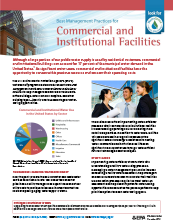
- Commercial & Institutional Facilities Fact Sheet(2 pp, 500 K, About PDF)
- Download the full WaterSense at Work guide (308 pp, 6 MB, About PDF)
Each of the 36 BMPs in the guide provides an overview of the technology, tips for operation, maintenance, and user education, options for retrofits and replacements, and calculations for potential water, energy, and dollar savings and payback periods.
- Monitoring and Education
Actively monitoring water use and effectively educating facility staff, building occupants, employees, and visitors about water use and water management planning goals are key components of properly managing and reducing facility water use. Monitoring and education set the stage for a successful water management program.
Section 2 of WaterSense at Work, Water Use Monitoring and Education, provides information about:
- Metering and submetering
- Leak detection and repair
- User education and facility outreach
- Codes, standards and voluntary programs for water efficiency
- Sanitary Fixtures and Laundry
Sanitary fixtures and equipment in restrooms and laundries can account for nearly 50 percent of total water use within a facility and can provide significant opportunities for water and energy savings, particularly in older buildings with inefficient fixtures and equipment.
Percent Water Use Attributed to Sanitary Fixtures and Equipment
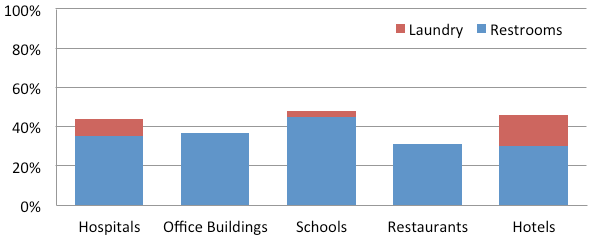
Section 3 of WaterSense at Work, Sanitary Fixtures and Equipment, provides information on equipment that nearly every type of commercial and institutional facility has including:
- Toilets
- Urinals
- Faucets
- Showerheads
- Laundry equipment
Learn how a hotel in San Antonio saved water and money by retrofitting their bathrooms with water efficient fixtures.
- Kitchen Equipment
In restaurants, water use in the kitchen can account for nearly 50 percent of the facility's total water use. Kitchen use in other commercial and institutional sectors, including hospitals, offices, schools, and hotels, can account for upwards of 10 to 15 percent of the facility's total water use. The chart below shows the percentage of facility water use that is attributed to kitchens for various commercial facility types.
Percent Water Use Attributed to Commercial Kitchen Equipment
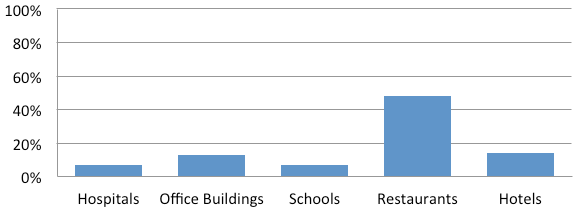
Water use will vary depending upon the scope and scale of the kitchen's operations, with larger kitchens using more water in almost every aspect of their operations when compared to smaller kitchens.
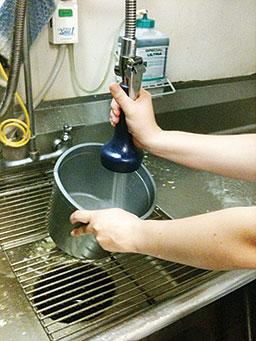 New water-efficient technologies and better water-saving practices can significantly reduce commercial kitchen equipment water and energy use. For example, ENERGY STAR® qualified dishwashers, ice machines, and steam cookers are at least 10 percent more water efficient and 15 percent more energy efficient than standard models, with some models saving significantly more.
New water-efficient technologies and better water-saving practices can significantly reduce commercial kitchen equipment water and energy use. For example, ENERGY STAR® qualified dishwashers, ice machines, and steam cookers are at least 10 percent more water efficient and 15 percent more energy efficient than standard models, with some models saving significantly more.Section 4 of WaterSense at Work, Commercial Kitchen Equipment, provides an overview of and guidance for effectively reducing the water use of:
- Commercial ice machines
- Combination ovens
- Steam cookers
- Steam kettles
- Wok stoves
- Dipper wells
- Pre-rinse spray valves
- Food disposals
- Commercial dishwashers
- Wash-down sprayers
Learn how three restaurants in Chicago, Illinois; Omaha, Nebraska; and Washington, D.C.; saved water and energy by implementing several best management practices.
- Outdoor Water Use
Outdoor water use can account for between 5 and 30 percent of a facility's total water use, as shown below. Better landscaping and pool maintenance practices and more efficient irrigation equipment can provide opportunities for significant water savings in commercial settings.
Percent Water Attributed for Outdoor Use
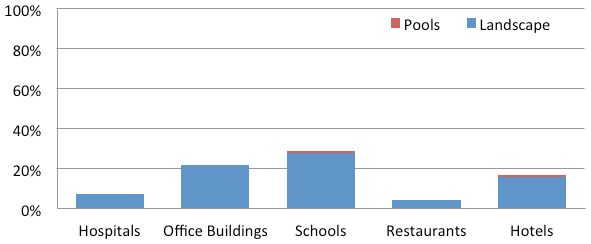
Facilities can use significant amounts of water to maintain and irrigate their surrounding landscape, depending on the size and design of the landscape, local climate, and facility type. Facilities with large areas of maintained landscape, such as schools, can use as much as 30 percent of their water for landscape maintenance. Outdoor water use can be controlled and minimized with proper landscape design and maintenance of any supplemental irrigation systems.
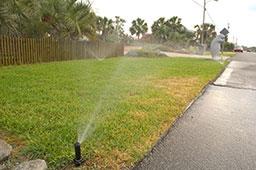 Many facilities also consume significant amounts of water for the operation and maintenance of pools and vehicle washing stations. Proper pool management can reduce water loss associated with evaporation, filter cleaning, mineral buildup control, leaks, and splashing. Vehicle washing stations can save at least 50 percent of the water used by reclaiming and reusing water.
Many facilities also consume significant amounts of water for the operation and maintenance of pools and vehicle washing stations. Proper pool management can reduce water loss associated with evaporation, filter cleaning, mineral buildup control, leaks, and splashing. Vehicle washing stations can save at least 50 percent of the water used by reclaiming and reusing water.Section 5.0 of WaterSense at Work, Outdoor Water Use, provides an overview of and guidance for effectively reducing the water use associated with:
- Landscaping
- Irrigation
- Commercial pool and spa equipment
- Vehicle washing
Learn how the Granite Park office complex in Plano, Texas, saved nearly 12.5 million gallons of water by increasing the efficiency of the irrigation system.
The U.S. Golf Association's (USGA) Golf's Use of Water Resource Center Exit includes information, best management practices, and case studies on how water can be used more efficiently on golf courses. Some of the information may also be useful for facility managers overseeing large landscapes.
- Mechanical Systems
Mechanical systems are used in nearly every type of commercial and institutional facility to provide building heating and cooling. Some also use mechanical systems to cool specific pieces of equipment, such as vacuum pumps, X-ray equipment, and ice machines. Levels of water use vary widely for different commercial facility types, amounting to as much as 30 percent of the total water use within a facility as shown below.
Water Use Attributed to Mechanical Equipment for Heating and Cooling
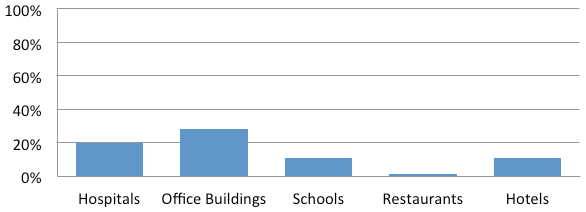
Energy- and water-efficiency measures should be implemented together throughout the facility to decrease the heating and cooling load of the entire system. Increasing the efficiency of the overall systems results in significant reductions in energy and water usage while creating cost savings.
 To reduce mechanical system water use, facilities should first eliminate single-pass cooling or reuse that water, then evaluate cooling towers, chilled water systems, and other heating systems to maximize efficiency. In some cases, single-pass cooling can be the single largest water user at a facility, using approximately 40 times more water to remove the same heat load than a cooling tower operating at five cycles of concentration. Ensuring that cooling towers and chilled water systems are properly maintained will minimize the amount of cold water needed to remove heat from equipment. Water use can also be optimized in boiler and steam systems by returning steam condensate back into the system.
To reduce mechanical system water use, facilities should first eliminate single-pass cooling or reuse that water, then evaluate cooling towers, chilled water systems, and other heating systems to maximize efficiency. In some cases, single-pass cooling can be the single largest water user at a facility, using approximately 40 times more water to remove the same heat load than a cooling tower operating at five cycles of concentration. Ensuring that cooling towers and chilled water systems are properly maintained will minimize the amount of cold water needed to remove heat from equipment. Water use can also be optimized in boiler and steam systems by returning steam condensate back into the system.Section 6 of WaterSense at Work, Mechanical Systems, provides an overview of and guidance for effectively reducing the water use of:
- Single-pass cooling
- Cooling towers
- Chilled water systems
- Boiler and steam systems
Learn more about how the U.S. Environmental Protection Agency's Mid-Continent Ecology Division Laboratory in Duluth, Minnesota, eliminated single-pass cooling and reduced its potable water use by 90 percent.
- Laboratory and Medical Equipment
Laboratories and medical facilities have special operations and equipment that can consume a significant amount of water through water purification, sterilization, photographic and X-ray processes, and vacuum systems. As shown below, equipment such as steam sterilizers and reverse osmosis systems can account for 5 percent of a laboratory's total water use. Hospitals can attribute more than 15 percent of their total water use to laboratory and medical equipment, including steam sterilizers and X-ray processing equipment.
Laboratory Water Consumption
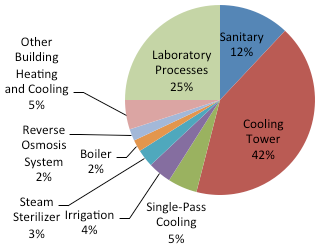
Hospital Water Consumption
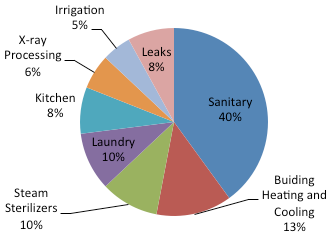
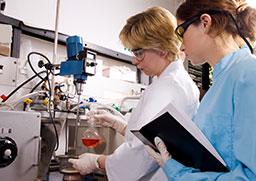 Laboratories and medical facilities may face unique challenges because of the high quality of the water required for their equipment to maintain purification and health and safety standards. These standards can limit the types of technologies that can be utilized, but many improvement opportunities still exist. Water efficiency alone will not be a driver in the choice of technologies or processes in these facilities, but it should be a consideration after other requirements have been met.
Laboratories and medical facilities may face unique challenges because of the high quality of the water required for their equipment to maintain purification and health and safety standards. These standards can limit the types of technologies that can be utilized, but many improvement opportunities still exist. Water efficiency alone will not be a driver in the choice of technologies or processes in these facilities, but it should be a consideration after other requirements have been met.Section 7 of WaterSense at Work, Laboratory and Medical Equipment, provides an overview of and guidance for effectively reducing the water use of:
- Water purification
- Vacuum pumps
- Steam sterilizers
- Glassware washers
- Fume hood filtration and wash-down systems
- Vivarium washing and watering systems
- Photographic and X-ray equipment
Learn how Providence St. Peter Hospital in Olympia, Washington, saved 31 million gallons of water by installing water-efficient laboratory and medical equipment and implementing many additional best management practices described in WaterSense at Work.
- Alternative Water Sources
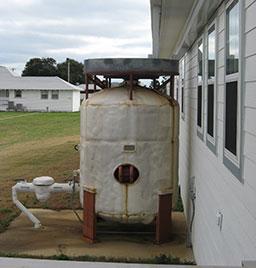 Facilities can further reduce potable water use by taking advantage of onsite alternative water sources, in which water discharge from one application or process is captured, treated, and utilized in another application. These onsite alternative water sources can vary greatly in quality and must be carefully matched with an appropriate end use.
Facilities can further reduce potable water use by taking advantage of onsite alternative water sources, in which water discharge from one application or process is captured, treated, and utilized in another application. These onsite alternative water sources can vary greatly in quality and must be carefully matched with an appropriate end use.Potential onsite alternative water sources include:
- Rainwater/stormwater
- Foundation drain water
- Treated gray water
- Condensate from air handler equipment
- Filter and membrane (e.g., reverse osmosis system) reject water
- Cooling equipment blowdown
Although discharge from single-pass cooling systems can be a suitable onsite alternative water source, facility managers should first consider eliminating single-pass cooling, as described in Section 6.2: Single-Pass Cooling of WaterSense at Work (308 pp, 6 MB, About PDF). If elimination is not possible, then consider reuse of the discharge water for another purpose.
General considerations for reuse of onsite sources of water include the quality constraints of the source and the potential types of treatment that may be needed to meet the quality needs of the proposed end use. Every situation is different, but many resources provide guidance on typical considerations.
Section 8 of WaterSense at Work, Onsite Alternative Water Sources, describes potential uses of onsite alternative water including:
- Irrigation
- Cooling tower make-up water
- Toilet and urinal flushing
- Make-up water for decorative ponds, fountains, and waterfalls
- Processes or other uses not requiring potable water
- Fume hood scrubbers
Learn more about how the University of Texas at Austin used onsite alternative water sources to reduce its potable water use by more than 33 percent.
